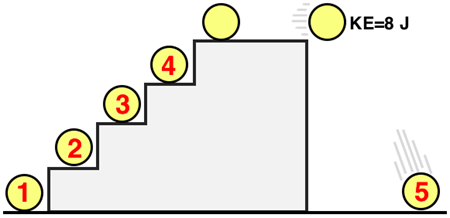The gravitational potential energy (PE) is dependent upon the height of the object. They are directly proportional such that a doubling of the height will double the PE and a halving of the height will halve the PE.
Under certain circumstances, objects will conserve their total amount of mechanical energy over the course of their motion. The sum of their potential energy and kinetic energy will remain constant. As the object falls, there is a transformation of potential energy into kinetic energy (and back) while the total amount of these two forms remains the same.
Hold down the T key for 3 seconds to activate the audio accessibility mode, at which point you can click the K key to pause and resume audio. Useful for the Check Your Understanding and See Answers.
Stepping Up to PE and KE - helpMaster
There are multiple versions of this question that vary from one another in terms of their numerical values. Here is one of the countless number of possible questions.
Version 1:
Consider the 4-step staircase. All steps provide an equal elevation gain. The potential energy (PE) on the top step is 44.0 J. Determine the PE and KE values of the ball at the indicated positions.

PE1(J): __________
PE2(J): __________
PE3(J): __________
PE4(J): __________
PE5(J): __________
KE5(J): __________
Try this link to The Physics Classroom Tutorial for conducting an energy analysis:
Gravitational Potential Energy
Analysis of Situations in Which Mechanical Energy is Conserved